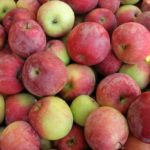- Harvest
- Spot the rot: One rotten apple can spoil an entire bushel
- Scab developed in storage
Hopefully, everyone somehow managed to obtain effective fungicide coverage during the wet summer of 2016, and the torrential rains of the last few days. Unfortunately, many of the diseases you thought you successfully battled all summer long might still show up now at harvest, and even in a few weeks post-harvest. It is important to recall that these infections happened all the way back in late June through July.
Although the weather has been hot, it has also been EXTREMELY wet, which means apple scab, the summer rots (black, white and bitter), and sooty blotch/flyspeck can still appear at harvest, or later appear in storage in what was thought as clean fruit. Depletion of fungicide residues (due to heavy rains, or waiting too long between applications, or simply trying to save a spray) and/or fungicide resistance provides allows latent infections to occur; you may not have seen it at harvest, but it can develop when fruit is stored, and surprise you in a bad way, like a scary clown.
Using a pre-harvest spray prior to the planned harvest date should provide sufficient residue to prevent pinpoint scab, summer rots and flyspeck/sooty blotch from growing after harvest. You may wish to target high value cultivars (e.g., Honeycrisp) to receive a final application of Pristine+ Captan or Merivon+Captan before harvest. These tank-mix combinations of fungicides have a 0-day PHI. Other strobilurins like Flint or Sovran, or the premix Luna Sensation have longer PHIs, and will not provide the necessary protection in storage with their longer (14d)PHI. If using captan or Merivon as that final spray, be careful if also applying Harvista or Retain, which may be applied with a 1% summer oil or 0.05% Silwet. Combinations with captan+Oil, merivon+captan+oil, and Silwet+Captan have been reported to be phytotoxic to fruit.
Harvesting fruit at the right maturity with little bruising is important in the management of postharvest rots. Cool fruit as rapidly as possible. After harvest, minimize the risk of condensation (also called ‘sweat’) that sometimes occurs in cold storage, as it provides both surface moisture and humidity that allows pathogens to grow by keeping apples at the optimal temperatures (30- 32 degrees F). Remember: Apples respire (sweat!) and soften twice as fast at 40 degrees F than at 32 degrees F. Sweaty apples are favored by the pathogens that were present going into storage. Remember your disease triangle and recognize that you have a host with a pathogen–don’t give them a favorable environment, too! There is little that can be done at this stage to latently infected apples, but symptoms can be delayed by proper storage.


